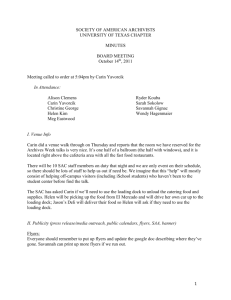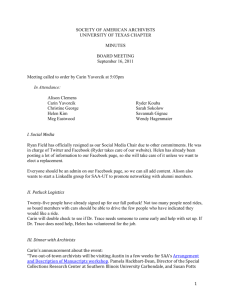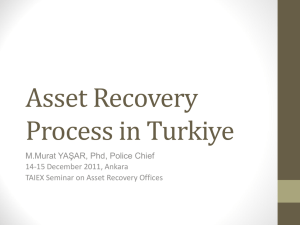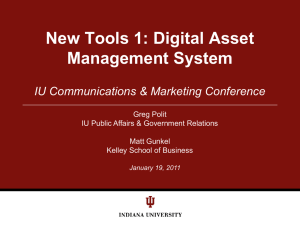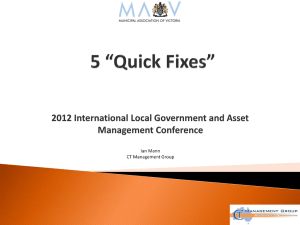Thailand Mr.Keebong Paek
advertisement
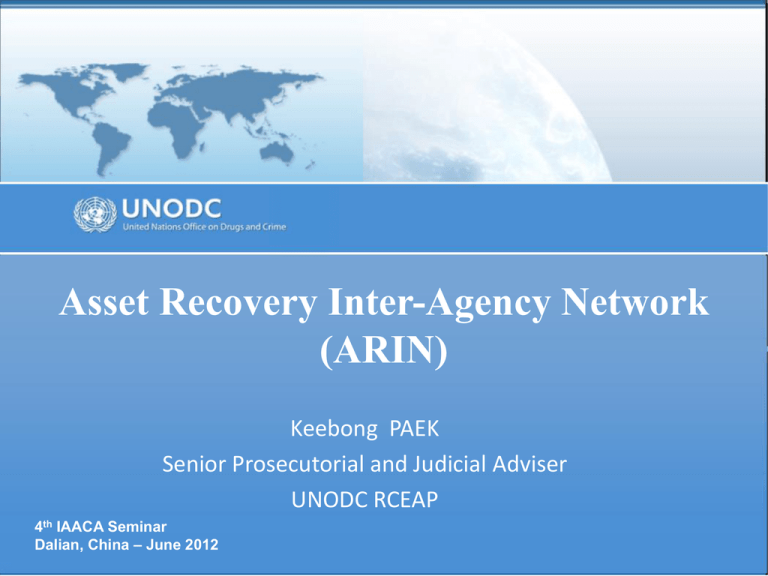
Asset Recovery Inter-Agency Network (ARIN) Keebong PAEK Senior Prosecutorial and Judicial Adviser UNODC RCEAP 4th IAACA Seminar Dalian, China – June 2012 Contents I. Introduction 1. 2. 3. Global Architecture National Regime Challenges II. ARIN 1. 2. 3. CARIN ARIN-SA RRAG III. ARIN-SEA I. Introduction Most crimes are committed for financial gains – confiscation attacks the core motive and prevents criminal assets from being used for other crimes Confiscation targets decision-makers and beneficiaries It may have a deterrent effect: “crime doesn’t pay” – “follow the money” Relatively limited number of confiscation cases and modest amounts recovered if compared to estimated revenue of organized criminal groups 1. Global Architecture Vienna Convention UNTOC UNCAC FATF rev. 40 Rec. Nat. Leg’n Pros. Inv. Nat. Leg’n Pros. Nat. Leg’n Inv. Pros. Inv. 2. National Regime Law Org. Confiscation Financial System FIU Act FIU Information Legal System AML Act Regulation Prosecutor / Law Enforcement Agency Conviction Non-conviction 3. Challenges Problems with national legislation multi-agency coordination Prosecutor/Investigator skills Barriers to formal/informal cooperation International: MLA slow/no informal structures II. ARIN : Initiatives to Overcome Asset Recovery Inter-agency Network Current Networks: 1. CARIN (Camden) 2. ARINSA (Southern Africa) 3. RRAG (South America) 1. CARIN Informal network of judicial and law enforcement practitioners, who are experts in the field of asset tracing, freezing, seizure and confiscations Why the need for a network? Cross-border fight against transnational crime receives support from many international conventions and other international instruments In practice, these measures can only be applied with effective cross-border, inter-agency cooperation CARIN Launch Congress : 2004 - Netherlands CARIN – Structure, aims and objectives Two contacts from each member jurisdiction or organization (almost 60) - One from a law enforcement agency - One from a judicial authority Small steering group (9 members) Presidency – changes annually Europol – permanent secretariat CARIN – Structure, aims and objectives The aim of CARIN is to increase the effectiveness of members’ efforts on a multiagency basis, in depriving criminals of their illicit profits Nine objectives to assist to meet the aim CARIN – Key objectives: • • Focus on the proceeds of all crimes; • • • • • Encourage members to establish national asset recovery offices; • Emphasize the importance of cooperation with the private sector in achieving its aim; • Facilitate, where possible, training in all aspects of tackling proceeds of crime. Establish itself as a centre of expertise on all aspects of tackling the proceeds of crime; Establish a network of contacts; Promote the exchange of information and good practice; Act as an advisory group to other appropriate authorities; Undertake to make recommendations to bodies ………………., relating to all aspects of tackling the proceeds of crime; 2. ARINSA Members - Botswana, Lesotho, Mauritius, Namibia, South Africa, Swaziland, Tanzania, Zambia, Zimbabwe - Malawi, Nigeria First Annual General Meeting (July, 2010) Secretariat - AFU(Asset Forfeiture Unit), SA 3. RRAG GAFISUD (Grupo de Acción Financiera de Sudamérica) - FATF-style regional body in South America (2000) - Members : Argentina, Bolivia, Brazil, Chile, Colombia, Costa Rica, Ecuador, Mexico, Panama, Paraguay, Peru, Uruguay RRAG (Red de Recuperación de Activos de GAFISUD, 2010) - GAFISUD’s asset recovery network Secretariat - GAFISUD Secretariat Office (Argentina) III. ARIN-SEA Asset Recovery Inter-agency Network of South East Asia Structure Individual prosecutors/ investigators Secretariat ARINSEA Member country Contact points (prosecutors/ investigators) Structure ARINSEA Structure CARIN ARINSEA Structure CARIN ARINSEA Structure CARIN ARINSEA Structure CARIN ARINSEA Structure South American Network RRAG CARIN ARINSEA Southern Africa ARINSA How can Inter-agency Network be used? • • • • • • Identify/trace property Advise on local laws/procedures Discuss MLA options Info. requirements Discuss strategies Develop professional relationships How can Inter-agency Network be used? < It is NOT a substitute for formal MLA > • It should: - Add direction Expedite/Increase speed Improve understanding Reduce confusion/delay Develop professional relationships Spread the benefit of local knowledge throughout the network and beyond THANK YOU keebong.paek@unodc.org
